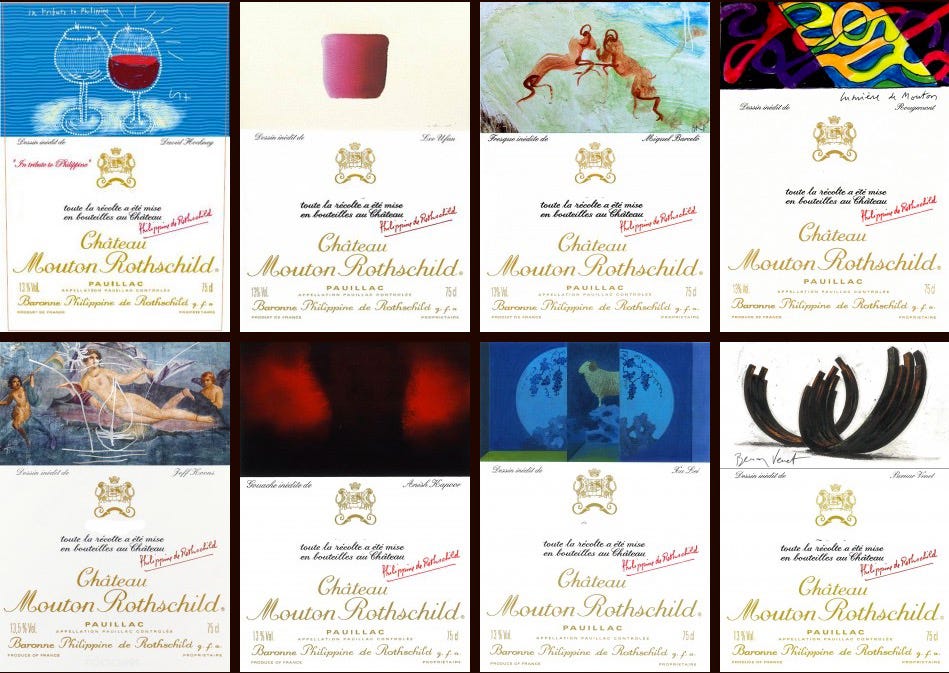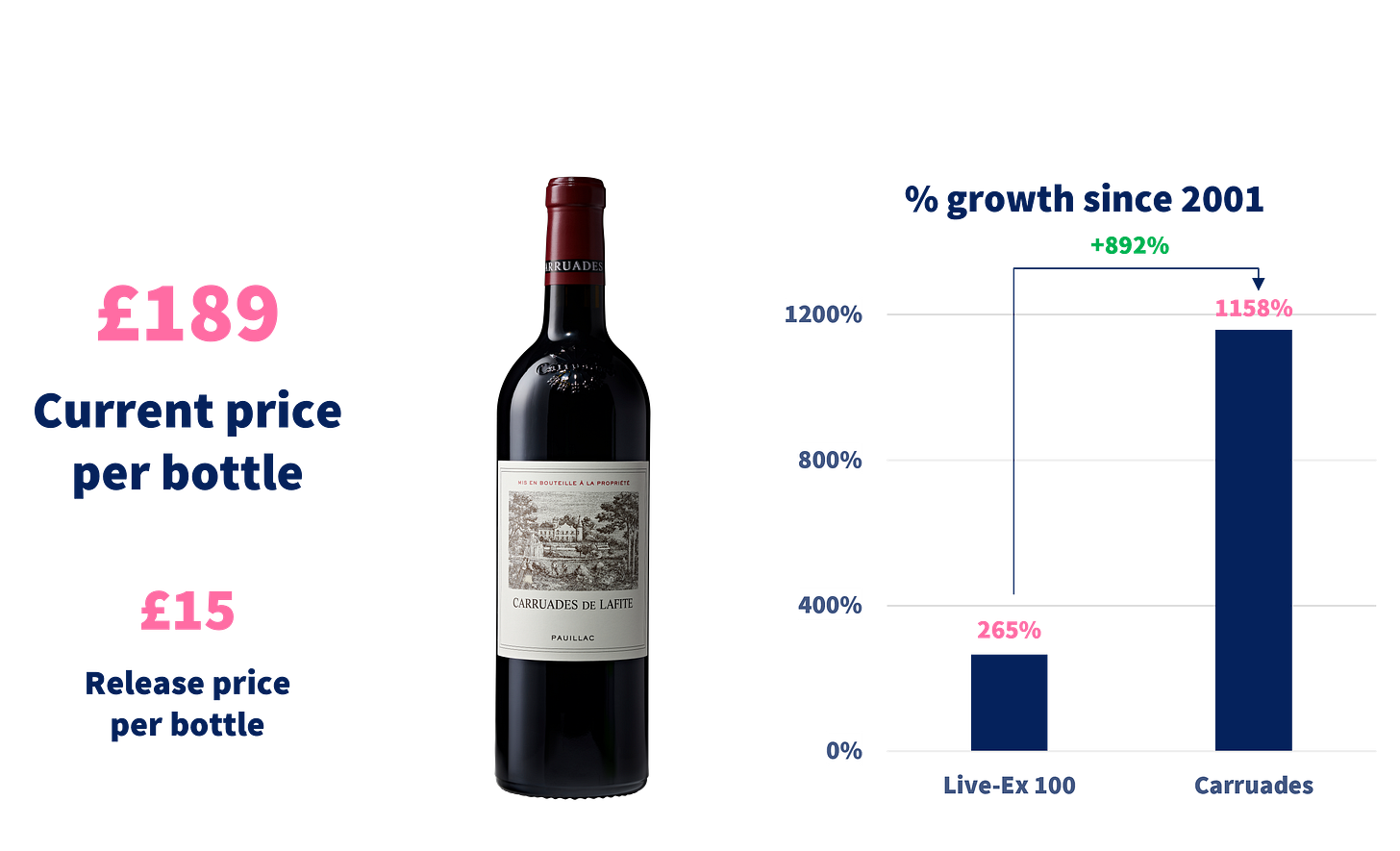We’ve outlined why you should consider investing in wine. The next obvious question is: which wine(s) should you buy for investment purposes?
We’ve got some exclusive data for you! We asked our latest podcast guest, Cult Wines, which were the best performing wines released since 2000. They have kindly provided the answer.
5th place: Chateau Mouton Rothschild, 2000
Chateau Mouton Rothschild is one of five Chateaus classified as “first growth” on the left bank in Bordeaux. This is top tier stuff.
The Rothschild family know how to make exceptional wine and with this bottling they also get creative. Each vintage, they commission a famous artist (e.g. Picasso, Warhol etc) to design the labels (see image below).
This is a wine you can drink, invest in or just look at. It’s an all-time classic.
Investment tip: buy the best wine from the best producers in the best vintages. As supply dwindles, it is really unlikely the price will not appreciate.
4th place: Carruades de Lafite, 2001
Another left bank Bordeaux and another wine produced by the Rothschild family. Chateau Lafite is also classified as a “first growth” and is on a shortlist of the most famous wines in the world. If we had to guess, we would probably say it’s number one.
However, the performance of this wine surprised us. Nowadays, pretty much all the top Chateau in Bordeaux produce a “second wine”, made up of the fruit that might not be quite right for the “Grand vin”. They are popular because:
they are ready to drink slightly sooner than the “Grand vin”
they give you a taste of the top wine without the jaw-dropping price tag
Carruades is the “second wine” of Chateau Lafite and the 2001 was a sensational investment, outperforming the “Grand vin”.
Investment tip: “second wines” carry the reputation of a producer, but sometimes at a fraction of the price. Assuming the release price is sensible (which is not always the case), they can provide great returns.
3rd place: Vosne-Romanée, 1er Cru, Aux Malconsorts, Domaine Sylvain Cathiard, 2004
Step aside Bordeaux and welcome Burgundy.
The northern section of the region is known as the Côte de Nuits, in which there is a commune called Vosne-Romanée. Simply put, this is where some of the greatest wines in the world are produced.
Aux Malconsorts is one of the top Premier Cru vineyards in Vosne-Romanée and situated right next to a string of Grand Cru vineyards (a more esteemed status).
It’s no surprise this wine has generated great returns. You get Grand Cru quality, but at a slightly lower price. Very appealing for fine wine drinkers!
Investment tip: do your homework and research the strategically situated vineyards in Burgundy. They often represent good investment opportunities.
2nd place: Gevery-Chambretin, 1er Cru, Clos Saint-Jacques Vieille Vignes, Domaine Fourrier, 2005
If there is a challenger to Vosne-Romanée’s crown, it is Gevery-Chambretin. Who better to tend to vineyards in such illustrious land as Jean-Marie Fourrier.
Jean-Marie took over the family Domaine at the tender age of 23. The Domaine’s cellars were described by Robert Parker (famous and controversial wine critic) as the “dampest and dirtiest in all of Burgundy”. Work to be done.
Jean-Marie renovated the cellars and installed new equipment. Perhaps more importantly, he took immense care of the Domaine’s vineyards and drastically reduced yields.
Domaine Fourrier now produce exceptional wine each year and they are always in very high demand. Unfortunately, that also means the prices for the wines have skyrocketed. If only we knew the magic Jean-Marie would work when he took over the Domaine in the 1990s.
Investment tip: when Domaines with top vineyards are handed down to the next generation, there is opportunity for change. Catch a generational producer at the beginning of their career and your bank balance will thank you (hopefully your palate will too).
1st place: Vosne-Romanée, Grand Cru, Romanée-Conti, Domaine de la Romanée-Conti, 2004
It’s hard to write about “The World’s Most Fabled Wine”. This is the GOAT for investment and drinking. Enough said.
Investment tip: use the returns from your other investments to try this at least once. It’s the ultimate wine experience. Clouds will part and the heavenly choirs will sing. Or you can cash in and use the capital to fund a lifetime’s wine consumption.
That’s a wrap
When you consider that the S&P 500 index has provided investors an annualised return of 7.7% since 1928, you start to see why fine wine is an attractive asset class. The annualised return of the wines featured in this article ranges from 44% up to 151% (see image below). Mighty impressive!
Of course, we are looking at the top trumps in this post and not all wines perform as strongly. Furthermore, the producers, importers and investors are well aware of how significantly the prices have increased. The top performers in the future might be more esoteric wines outside of Bordeaux and Burgundy. You should seek advice before investing your hard-earned cash.
On that note, we want to say a huge thank you to Tom Gearing and the team at Cult Wines for providing the data and letting us share it with you.
We will be less heavy on the data next week, as we are featuring one of our favourite London restaurants on the podcast. SPOILER ALERT - we will be sharing a recipe from their new chef in residence. Stay tuned and have a fabulous weekend.
Source: The market value and analysis presented was prepared by Cult Wines, utilising price data from Wine-Searcher. Prices and values are accurate as of April 23, 2024. Release prices, referenced as "Ex-London Release Price" have been referenced from Liv-ex (The London International Vintners Exchange). The performance of each wine has been compared against the Liv-ex Fine Wine 100 index as a benchmark for this analysis.
Disclaimer: Every wine listed here has a documented Ex-London Release Price, though the actual price paid may vary depending on availability and specific purchase conditions at the time of release. Past performance is not indicative of future success; the performance was calculated in GBP and will vary in other currencies. Any investment involves risk of partial or full loss of capital. The results depicted here are not based on actual trading and do not account for the annual management fees that may be charged to a Cult Wines customer, and there is no guarantee of similar performance with an investor’s particular portfolio.












